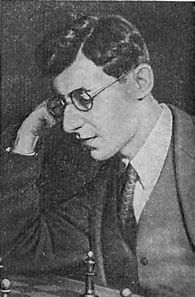wordfunph: Part Two
10...Qa5 11.Bd2 Qc7 12.Nd4 0-0 13.f4 Rfc8 14.g4 Nxg4?
Khismatullin is known as a fine defender, and basically waves a red flag in front of his opponent with this move. Safer would be to play 14...Be8 15.g5 Nd7 with chances for both sides.
15.Rhg1 Nf6
Of course not 15...Nf2? 16.Qg3!
16.f5! <D>
Position after 16.f5
16...e5 17.Bh6! Bf8
[17...exd4 is met by 18.Bxg7 dxc3 19.Bh6+ Kh8 20.Qg3 cxb2+ 21.Kb1 Nh5 22.Bg7+ Kg8 23.Qg4 Nf4 24.Bxb2+ (Please do not fall for 24.Qxf4? Ba4! when White must bail out to perpetual check) 24...Ng6 25.fxg6 fxg6 (25...hxg6 26.Qh5!) 26.Qe6+ Kf8 27.Rgf1+ Ke8 28.e5! The Black King is doomed.
18.Rxg7+! Bxg7
Quietly moving the king won’t work either: 18...Kh8 19.Rdg1 exd4 20.Qg3 mate coming up.
19.Rg1
[19.Qg3? Nh5!]
19...Nh5 20.Bxg7 exd4
[20...Nxg7 21.f6 Qd8 22.Rxg7+ Kh8 (22...Kf8 23.Rg8+! Kxg8 24.Qg3+ Kf8 25.Qg7+ Ke8 26.Qg8+ Kd7 27.Qxf7+ Qe7 28.Qxe7#) 23.Qh3 the end]
21.Bxd4+ Kf8 22.Qh3 Ke7 23.Qxh5 Rf8 24.e5! Rad8
The reply to 24...dxe5 is 25.Bc5+ Ke8 (25...Kd7 26.Rd1+ Ke8 27.Qh6 Rg8 28.Qxh7 Rf8 29.Qg7) 26.Bxf8 Kxf8 27.Qxh7 the attack is winning.
25.exd6+ Rxd6 26.Bc5 Qa5
[26...Rfd8 27.f6+! Kd7 (27...Kf8 28.Qg4 Ke8 29.Re1+ etc) 28.Bxd6 Kxd6 29.Rd1+ Ke6 30.Re1+ Kd6 31.Qe5+ Kd7 32.Qf5+ Kd6 33.Rd1+]
27.Bxd6+ Kxd6 28.Qh6+ 1-0
And Black resigned because he is losing the rook on f8.
One question that I frequently come across is why Black can’t immediately transpose to an ending with the two bishops with 1.e4 c5 2.Nf3 d6 3.d4 cxd4 4.Qxd4 Nc6 5.Bb5 Qa5+ 6.Nc3 Qxb5 7.Nxb5 Nxd4 8.Nfxd4.My experience with this, and I have played literally hundreds of games against this treatment, is that White’s better development and space advantage give him the edge. There has been a recent game which confirms this thesis.
Zhigalko, Sergei (2668) -- Tihonov, Jurij (2472) [B53]
76th ch-BLR Minsk BLR (6), 17.01.2010
1.e4 c5 2.Nf3 d6 3.d4 cxd4 4.Qxd4 Nc6 5.Bb5 Qa5+?!
Surprisingly, this maneuver comes up a lot. But that is ok, because I think white gets a superior ending which even I with my poor endgame skills wins a majority of the time.
6.Nc3 Qxb5 7.Nxb5 Nxd4 8.Nfxd4
Black has to move his king.
8...Kd8
Zhigalko has made a good living from this line. Take a look: 8...Kd7 one example: 9.c4 g6 10.f3 a6 11.Nc3 e6 12.Be3 Kc7 13.a4 Bd7 14.a5 Rc8 15.Na4 Bxa4 16.Rxa4 Nf6 17.Ke2 Nd7 18.b4 Bg7 19.b5 Nc5 20.Rb4 Rhe8 21.Rd1 Be5 22.g3 h5 23.bxa6 bxa6 24.Nb3 Nxb3 25.Rxb3 Rb8 26.Bb6+ Kc6 27.Rbd3 g5 28.Ke3 White is already winning. Zhigalko, S (2562) -- Aulin Jansson, J (2279)/ Kemer 2007 1-0 (35).
9.c4 Nf6 10.f3 Bd7
Look it up in Megabase 2011: White has a 100% score in the line after 10...a6 -- it weakens the b6 square. Here is a sample: 11.Nc3 e6 12.a4 Bd7 13.b3 Rc8 14.Bb2 Be7 15.0-0-0!? Kc7 16.Ba3 Rhe8 17.Kb2 White will slowly build up the position. Degraeve, J. (2530) -- Vachier Lagrave, M. (2458)/ France (ch) 2004 1-0 (35).
11.Bd2 e5?!
Black tries to open up the position so that his two bishops will count.
12.Ne2 Bxb5 13.cxb5 h6
White was intending Bg5xf6 followed by Ne2-c3-d5, so Black prevents it right away.
14.0-0-0 Be7 15.Bc3!? Kc7 16.Rd3 Kb6 17.a4 a6?! 18.bxa6 bxa6 19.Bb4 Rhc8+ 20.Nc3 Rc6 21.Rhd1 Kc7 22.Kb1 Rb8 23.Ba3 Bf8 24.a5 Kd7 25.Na2!
A typical knight maneuver here -- the steed wants to go to b4 to attack the a6-pawn.
25...Ra8 26.Nb4 Rcc8 27.Nd5 Nxd5 28.Rxd5
Black loses a pawn.
28...Rc6 29.Rxe5 Rac8 30.Red5 Ke6 31.f4 g6 32.g4 Rc4 33.Bxd6 Rxe4 34.Bxf8 Rxf8 35.Rd6+ Ke7 36.f5 Rb8
[36...Rxg4?? 37.f6+ Ke8 38.Rd8#]
37.f6+ Ke8 38.Rxa6 Rxg4 39.Rb6 1-0
So what are you waiting for? Try the Sicilian Chekhover!
Reader comments/suggestions are solicited. E-mail address is bangcpa@gmail.com







